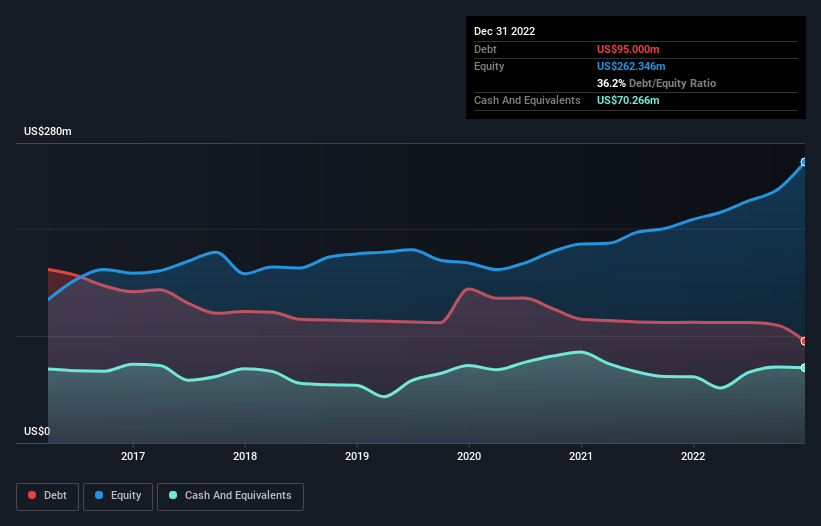- United States
- /
- Electronic Equipment and Components
- /
- NasdaqGS:BELF.A
Here's Why Bel Fuse (NASDAQ:BELF.A) Can Manage Its Debt Responsibly
Warren Buffett famously said, 'Volatility is far from synonymous with risk.' When we think about how risky a company is, we always like to look at its use of debt, since debt overload can lead to ruin. Importantly, Bel Fuse Inc. (NASDAQ:BELF.A) does carry debt. But the more important question is: how much risk is that debt creating?
When Is Debt A Problem?
Debt is a tool to help businesses grow, but if a business is incapable of paying off its lenders, then it exists at their mercy. Part and parcel of capitalism is the process of 'creative destruction' where failed businesses are mercilessly liquidated by their bankers. However, a more frequent (but still costly) occurrence is where a company must issue shares at bargain-basement prices, permanently diluting shareholders, just to shore up its balance sheet. By replacing dilution, though, debt can be an extremely good tool for businesses that need capital to invest in growth at high rates of return. The first step when considering a company's debt levels is to consider its cash and debt together.
Check out our latest analysis for Bel Fuse
What Is Bel Fuse's Debt?
The image below, which you can click on for greater detail, shows that Bel Fuse had debt of US$95.0m at the end of December 2022, a reduction from US$112.6m over a year. However, it also had US$70.3m in cash, and so its net debt is US$24.7m.

How Strong Is Bel Fuse's Balance Sheet?
We can see from the most recent balance sheet that Bel Fuse had liabilities of US$136.3m falling due within a year, and liabilities of US$161.8m due beyond that. Offsetting these obligations, it had cash of US$70.3m as well as receivables valued at US$107.3m due within 12 months. So its liabilities total US$120.6m more than the combination of its cash and short-term receivables.
While this might seem like a lot, it is not so bad since Bel Fuse has a market capitalization of US$435.9m, and so it could probably strengthen its balance sheet by raising capital if it needed to. However, it is still worthwhile taking a close look at its ability to pay off debt.
We measure a company's debt load relative to its earnings power by looking at its net debt divided by its earnings before interest, tax, depreciation, and amortization (EBITDA) and by calculating how easily its earnings before interest and tax (EBIT) cover its interest expense (interest cover). This way, we consider both the absolute quantum of the debt, as well as the interest rates paid on it.
Bel Fuse has a low net debt to EBITDA ratio of only 0.29. And its EBIT covers its interest expense a whopping 21.0 times over. So we're pretty relaxed about its super-conservative use of debt. Even more impressive was the fact that Bel Fuse grew its EBIT by 180% over twelve months. That boost will make it even easier to pay down debt going forward. There's no doubt that we learn most about debt from the balance sheet. But ultimately the future profitability of the business will decide if Bel Fuse can strengthen its balance sheet over time. So if you're focused on the future you can check out this free report showing analyst profit forecasts.
Finally, while the tax-man may adore accounting profits, lenders only accept cold hard cash. So it's worth checking how much of that EBIT is backed by free cash flow. Over the most recent three years, Bel Fuse recorded free cash flow worth 51% of its EBIT, which is around normal, given free cash flow excludes interest and tax. This free cash flow puts the company in a good position to pay down debt, when appropriate.
Our View
Bel Fuse's interest cover suggests it can handle its debt as easily as Cristiano Ronaldo could score a goal against an under 14's goalkeeper. And that's just the beginning of the good news since its EBIT growth rate is also very heartening. Zooming out, Bel Fuse seems to use debt quite reasonably; and that gets the nod from us. While debt does bring risk, when used wisely it can also bring a higher return on equity. There's no doubt that we learn most about debt from the balance sheet. But ultimately, every company can contain risks that exist outside of the balance sheet. For instance, we've identified 2 warning signs for Bel Fuse (1 is significant) you should be aware of.
If you're interested in investing in businesses that can grow profits without the burden of debt, then check out this free list of growing businesses that have net cash on the balance sheet.
Valuation is complex, but we're here to simplify it.
Discover if Bel Fuse might be undervalued or overvalued with our detailed analysis, featuring fair value estimates, potential risks, dividends, insider trades, and its financial condition.
Access Free AnalysisHave feedback on this article? Concerned about the content? Get in touch with us directly. Alternatively, email editorial-team (at) simplywallst.com.
This article by Simply Wall St is general in nature. We provide commentary based on historical data and analyst forecasts only using an unbiased methodology and our articles are not intended to be financial advice. It does not constitute a recommendation to buy or sell any stock, and does not take account of your objectives, or your financial situation. We aim to bring you long-term focused analysis driven by fundamental data. Note that our analysis may not factor in the latest price-sensitive company announcements or qualitative material. Simply Wall St has no position in any stocks mentioned.
About NasdaqGS:BELF.A
Bel Fuse
Designs, manufactures, markets, and sells products that power, protect, and connect electronic circuits.
Flawless balance sheet and fair value.
Similar Companies
Market Insights
Community Narratives





